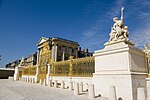Grande Commande

The grande commande was a commission ordered by Louis XIV for statues intended to decorate the parterre d’eau of the gardens of the Palace of Versailles, as initially conceived in 1672. The commission, which included 24 statues and four groups, was ordered in 1674. Designed by Charles Le Brun from Cesare Ripa’s Iconologia, the statues were executed by the foremost sculptors of the day (Blunt, 1980; Friedman, 1988, 1993; Nolhac, 1913; Thompson, 2006; Verlet, 1985). Owing to concerns of the effects of the vertical lines of the statues in relations to the garden façade of the château, the statues of the grande commande were transferred to other locations in the gardens in 1684 (Berger, 1985; Blunt, 1980; Friedman, 1988, 1993; Marie, 1968; Nolhac, 1901, 1913; Thompson, 2006; Verlet, 1985; Weber, 1993). The 24 statues were personifications of the classic quaternities: The four groupings represented the four classic Abductions: The Four Abductions:Persephone by Pluto Cybele by Saturn Orethyia by Boreas Coronis by Neptune
Excerpt from the Wikipedia article Grande Commande (License: CC BY-SA 3.0, Authors, Images).Grande Commande
Terrasse, Versailles
Geographical coordinates (GPS) Address Website Nearby Places Show on map
Geographical coordinates (GPS)
| Latitude | Longitude |
|---|---|
| N 48.8049 ° | E 2.1204 ° |
Address
Château de Versailles
Terrasse
78000 Versailles, Notre-Dame
Ile-de-France, France
Open on Google Maps










